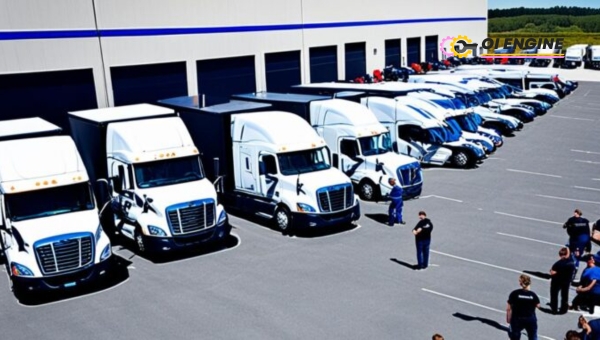Are you wondering how to get a CDL and kickstart a career in commercial driving? No doubt getting your Commercial Driver’s License (CDL) can open up several high-paying opportunities.
A CDL is your golden ticket to joining the ranks of professional drivers who keep our economy humming. Imagine life on the open road, the freedom of traveling cross-country, and knowing you play an essential role in delivering goods. It’s more than just driving; it’s about becoming part of a critical workforce.
So, how do you start this journey? First things first, determine which class of CDL you need – there are A, B, and C classes based on the vehicle type you intend to drive.
Then, grab yourself a Commercial Learner’s Permit (CLP), complete some entry-level driver training at an accredited school, and finally pass the CDL test with flying colors.
Also Useful: Form 2290 E-File Providers Top 5 Picks For Truckers
What is a CDL License?
A CDL or Commercial Driver’s License acts like your golden key, unlocking opportunities within professions that involve driving commercial vehicles. Be it trucks, buses, or small delivery vans, if you’re steering a vehicle for professional purposes you will be required to have a CDL.
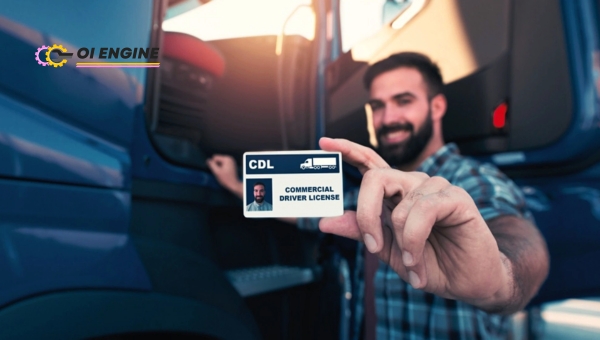
Here’s why having one is impressive – not only does it affirm your particular set of skills but it also boosts your career prospects! You become increasingly valuable to businesses due to your ability to drive their vehicles safely and efficiently.
This special license becomes necessary when regular driver licenses fall short in covering safety issues related to larger, heavier, and more complex vehicles used for commercial purposes. Think about semi-trucks hauling double trailers down highways.
In situations like these where safety rules are stricter and operating the vehicle involves technical handling skills, getting a grip on that CDL becomes mandatory.
What is a Commercial Learner’s Permit (also known as CLP or CDL permit)?
Before you rush out aiming for that shiny CDL right off the bat, pause there! First comes something called a Commercial Learner’s Permit or CLP. This preliminary step cannot be skipped over.
The permit’s purpose might not seem clear initially but believe me when I say this: It plays an important role in easing me into becoming confident with more serious-scale driving tasks involved with commercial vehicles.
Allowing myself time with my Learner’s permit meant I was exposed first-hand without overwhelming myself too fast.
Obtaining this learner’s permit lets newbies like us get real-time driving practice, under the observant eyes of a CDL holder in the vehicle.
This valuable chance to train in an authentic environment is what bridges me closer to earning a full-fledged CDL! I got mine from a state Driver’s License’s Office, after taking and passing the associated knowledge tests – which means it’s proof also that I have acquired the basic knowledge necessary for commercial driving.
Steps Required to Get a CDL License in 2025
Though it may seem daunting at first, the process of getting a Commercial Driver’s License (CDL) in 2024 is quite straightforward.
By taking one step at a time and staying focused, you can secure your CDL license without any unnecessary detours. Here are the fundamental steps that’ll help you reach your licensing goal.
Initial Research & Preparation
Before diving into the journey of securing your CDL, it’s crucial to gather all necessary information first. Start by understanding what a CDL entails and why it is important.
Your research may entail finding out about different types of commercial vehicles and which type you’d like to operate.
Also, familiarize yourself with federal regulations concerning commercial driving licenses as these rules might have changed over time or area-specific nuances. Exploring online resources or discussing with professional drivers may further enrich your knowledge base.
Remember, preparation is not just about gathering information but also preparing yourself physically and mentally for the test that lies ahead.
A driver’s physical health influences their command on heavy-duty vehicles; hence personal health shouldn’t be overlooked during this crucial phase.
Get a Commercial Learner’s Permit (CLP)
A Commercial Learner’s Permit (CLP) serves as an interim license allowing you to practice driving under surveillance until official CDL testing day arrives. Mind you; this isn’t something optional; obtaining CLP forms an integral part of acquiring full-fledged CDLs.
To get the CLP, I had to pass certain tests relating to my general driving knowledge and command over essential vehicle operations.
These were primarily written tests encompassing some practical elements too. Alongside these tests, federal regulations require me to pass vision tests before receiving my permit.
Once I procured the permit, I entered into the next phase- practice sessions under companion travel,i.e., driving along with licensed professionals.
After completing a mandatory number of supervised driving hours, I was then eligible for the actual permit drive test conducted by DMV.
Complete Entry-Level Driver Training (CDL School)
Upon getting your learner’s permit, it’s time to learn professional driving at an authorized CDL school. These schools provide the necessary driver training tailored specifically for commercial vehicle drivers.
They instill in you the critical skills required to operate heavy-duty vehicles and familiarize you with rules and regulations related to commercial driving.
Beyond technical skills, these schools offer comprehensive education on how to deal with emergencies or unexpected situations on the road.
As an aspiring driver, it was this education that helped me develop a more responsible perspective towards road safety. Remember that good knowledge coupled with excellent practical application hones your way toward successful CDL attainment.
Take the CDL Test
At this stage, you’re well prepared to go for the final CDL test. This test assesses everything learned so far — from theoretical knowledge to practical application of driving skills.
During my CDL final test, I had to go through two main sections – a written general knowledge exam and a road skills test.
The written part evaluated my understanding of laws and driving principles, while the road skills section tested my ability to competently handle intended commercial vehicles in various situations, including reversing, parking, and navigating through city roads or highways.
After clearing both these components of the examination successfully, I held my much-awaited Commercial Driver’s License!
Each step is a learning opportunity. Your determination coupled with careful preparation will be significant contributors in sailing smoothly through the process of getting your CDL license.
How much does it cost to get a CDL?
Seeking out the path of how to get a CDL also means understanding the costs involved in this venture. Depending on your location and specific needs, these prices can range greatly.
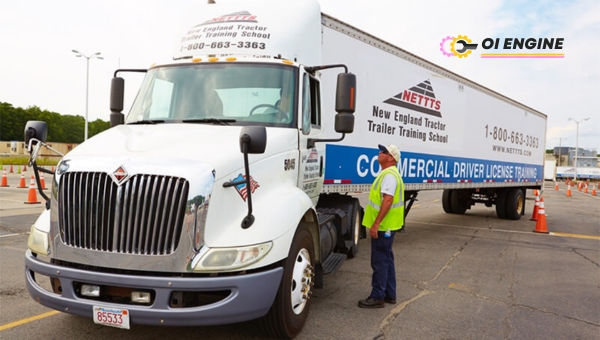
Without mincing words, embarking on this journey can be pricey, but remember, with the right support and planning, it’s possible.
Average Costs for Gaining a CDN
The process of achieving your commercial driver’s license (CDL) starts with determining your state’s requirements and their respective fees.
On an average basis, going through this process will likely cost you between $100 to $300- this projection includes application fees as well as written and road test charges. However, do note that prices may vary from state to state.
Moreover, most folks need more preparation than just studying at home before taking these tests. To better equip yourself for success, there are numerous training schools available that provide practical lessons on operating commercial vehicles like trucks or buses.
These courses typically charge between $1,000 to $7,000 depending on their duration and comprehensiveness.
Financial Assistance Available
As someone who’s figuring out how to get a CDL license without breaking the bank might sound challenging- worry not!
Various financial aids are offered across different platforms aimed at assisting budding commercial drivers like yourself.
- Quelques scholarships stand available specifically tailored towards individuals aiming to obtain their CDL certifications – be sure to research existing offerings in this regard both locally and nationally.
- Financial aid resources exist that offer low-interest loan alternatives specifically designed for career training purposes such as obtaining one’s CDL – again these would necessitate thorough research though they usually offer flexible payment methods suited for students of all backgrounds.
- Some companies, particularly those in desperate need of drivers offer paid training programs allowing recruits not only to receive hands-on training but also earn money while gaining their certification — talk about a win-win situation!
Embarking on a new profession often involves making investments, and getting your CDL is no different – Consider these costs as stepping stones rather than obstacles on your journey.
The Different Classes of CDL Licenses: A, B, C
To get a better understanding of “how to get a CDL”, it’s important to first grasp the differences between the various classes – Class A, B, and C.
Each class represents different types of vehicles you are permitted to drive, thus they come with their unique requirements and steps for obtaining them.
Consequently, the process differs based on the vehicle you’re planning to operate. Let’s delve deeper into each class.
How to Get a CDL Class A License?
A Commercial Driver’s License (CDL) Class A license allows you to operate any combination of vehicles with a Gross Vehicle Weight Rating (GVWR) of 26,001 pounds or more, given that the GVWR of the vehicle(s) being towed is over 10,000 pounds. It’s usually used for carrying large loads and heavy cargo.
Here are some basic steps for obtaining a Class A license:
- Study Protocol: Familiarize yourself with local rules and protocols about driving large trucks. Many free resources can be found online.
- Submit Application: File your application at your state’s Department of Motor Vehicles (DMV). Be prepared with relevant identification documents.
- Pass Vision Test: It is required in most states as part of your physical medical examination.
- Enroll in Training: Most states mandate attending driving school before taking tests – written knowledge and skills tests.
- Pass Exams: Success in both written knowledge tests & practical skills determines whether you will receive your CDL permit or not.
Once these steps are completed successfully without flouting any rules or regulations put forward by the Federal Motor Carrier Safety Administration FMCSA), one can easily obtain a Class A license.
How to Get a CDL Class B License?
A CDL Class B license permits individuals to drive a single vehicle weighing 26,001 pounds or more, or any such vehicle towing another not exceeding 10,000 pounds.
This particular license is mainly used for operating straight trucks, large passenger buses, box trucks, etc.
To obtain Class B CDL:
- Understand the Requirements: Research requirements and procedures that pertain to your state for acquiring a Class B license.
- Undertake the General Education Development (GED) Test: It is considered necessary before application in some states.
- Submit Application: Apply at your nearest state DMV office.
- Pass Written Tests & Driving Skills Evaluation: You will need to pass a general knowledge test and applicable endorsement tests depending upon the vehicle you’re planning on operating.
- Be at The Right Age: Minimum age restriction of 18 years is imposed on intra-state commercial driving while inter-state commercial driving requires minimum age of 21 years.
Success in these steps should enable you to secure your CDL Class B License.
How to Get A CDL Class C License?
Obtaining a CDL Class C license provides permission to drive vehicles designed to transport more than 16 passengers (including the driver) or are used in transporting hazardous materials that require warning placards under Department of Transportation regulations.
To acquire this class designation:
- Apply at DMV– Go ahead with the application process at the local DMV office after fulfilling federally imposed age restrictions.
- Pass Physical Examination– Undergo & clear standard physical examination routine as demanded by FMCSA for all commercial drivers irrespective of their intended vehicles’ category.
- Approach A Certified Driving School– Completion of training sessions & certification from a certified driving school can be beneficial.
- Clear Written Knowledge and Skills Test– Achieve satisfactory results in both tests i.e., understanding the operational theory behind driving and showcasing practical skills flawlessly.
Persistent efforts invested in a guided order as mentioned above will guarantee attainment of your CDL Class C License.
What are the Restrictions in The CDL?
When speaking about commercial driving licenses, it’s crucial to understand that specific restrictions may limit what you can do.
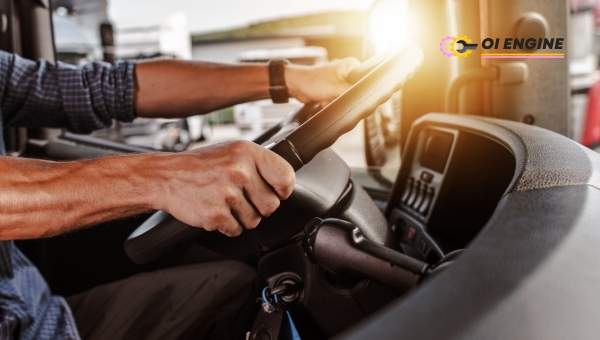
These limitations, designed by the Federal Motor Carrier Safety Administration (FMCSA), ensure the safety of both the driver and the public – limiting certain types of operations based on a driver’s experience or vehicle-related circumstances.
In simple words, a restriction placed on your CDL permits you to drive only under certain conditions.
Legally Imposed Restrictions
Understanding these legally imposed restrictions is essential for every aspiring commercial driver. Some typical examples of these restrictions include:
- L Restriction: This means no air brake-equipped CMV (Commercial Motor Vehicle). You’ll be issued an L restriction if you’re unable or unwilling to operate an air brakes-equipped vehicle during your skills test.
- E Restriction: This indicates no manual transmission CMV. This kind of restriction is placed when tests are done with automatic transmission vehicles.
- Z Restriction: This implies No Full air brake-equipped CMV. You will receive this limitation if you successfully conduct an Air Brake Check but fail the skills test in a vehicle with any braking system other than full air brakes.
These and several other encouraging safeguards help maintain roadway safety by ensuring that commercial drivers fully understand their equipment before operating without supervision.
Definitions and Implications
Elucidating further, let me share some definitions relevant to license restrictions and discuss their implications for those wondering how to get a CDL:
- A limitation is defined as something that limits one’s ability to engage in all possible activities and responsibilities aligned with one license type.
- An endorsement, on the other hand, gives explicit permission or approval for additional actions outside the original scope of your license.
- If a needed endorsement is not obtained despite regulatory requirements or if there is an apparent violation concerning limitations, stiff penalties might follow – including ticket fines or even suspension of your CDL license.
The nature and purpose of imposed traffic restrictions can be a vital determinant for successful commercial vehicle operation.
That’s why it’s significant to ponder these points diligently during the research phase when learning how to get a CDL. With legal knowledge on our side, we become ensured of safe and responsible conduct on the road.
Also Related: Discover 2025‘s 15 Best Fuel Cards For Truckers Now!
Learning About CDL Endorsements
As we dig deeper into the topic of Commercial Driver’s Licenses (CDLs), it’s vital to acknowledge the different types of CDL endorsements available.
These are special permissions or qualifications that enable a CDL holder to handle specific vehicles or ship certain goods.
CDL Endorsements
Primarily, there are six major types of endorsements associated with commercial driving and each one signifies unique proficiencies:
- T – This stands for Double/Triple Trailers endorsement. If you plan to pull more than one trailer, you need this endorsement.
- P – The Passenger endorsement permits you to drive commercial passenger vehicles such as buses.
- N – This is the Tank Vehicles endorsement, required if your cargo primarily consists of liquids/gases in bulk.
- H – Hazardous Materials endorsement (also known as HAZMAT); necessary for drivers transporting hazardous materials.
- X – It’s a combination of the Tank Vehicles and Hazardous Materials endorsements; proving itself fruitful when carrying dangerous liquids or gases.
- S – The School Bus endorsement allows you to transport students in a school bus.
Each one has its own set of tests that need to be passed before getting an endorsement on your license.
CLP Endorsements
Breaking down CLP or Commercial Learner’s Permit endorsements, they illuminate the path towards achieving a full-blown CDL.
The most essential ones include:
- P – Passengers are allowed to practice driving buses during training periods under supervision.
- S – School Bus authorizes practice with school buses while training under an expert driver guide.
- N – Tanker gives permit for practicing with tank vehicles under strict supervision.
Note: A Wrong Step taken can Implicit severe implications including potential license suspension!
How To Get A CDL Particular Endorsement?
Getting particular endorsements might seem tricky but it becomes seamless if you carefully follow the prescribed process. Depending on the specific endorsement, the agreed-upon terms must be fulfilled:
- L- Air Brake endorsement requires one to pass an air brake knowledge test.
- Z- No Full Air Brake Restriction removes restrictions upon passing necessary examinations.
- N – Tank Vehicle Obliges the driver to pass a special knowledge test for liquid cargo handling.
- E – Manual transmission Restriction Removal is needed if your CDL tests were taken on an automatic transmission vehicle.
- O – Over-size Load demands special training and permits due to extra-wide, long, or heavy cargo type.
- M – Motorcycle Endorsement allows you to drive motorcycles legally upon passing written and skills tests.
- V – Indicates that a medical variance has been recorded by the Federal Motor Carrier Safety Administration (FMCSA).
Admittedly, acquiring a particular endorsement goes beyond mere wishful thinking; it encompasses use-specific training, passing a relevant examination(s), and demonstrating aptitude through practice under expert supervision.
Federal Requirements for Commercial Drivers
When we talk about commercial driving, it’s important to understand that it’s not as simple as just hopping into the cab of a big rig and hitting the road.
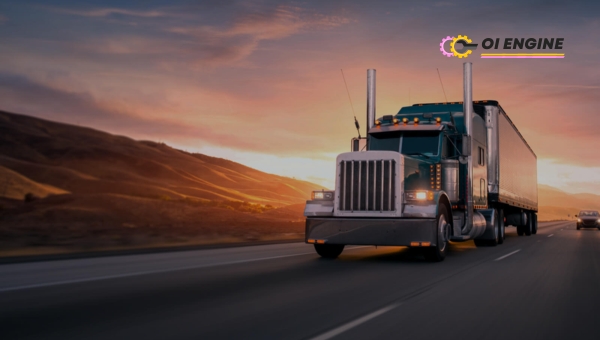
There is a specific set of federal requirements that must be adhered to in order not just to get your CDL but also to retain it.
CDL Federal Requirements
Here are some key points you should know about:
- Age: Federal law dictates that all commercial drivers operating interstate must be at least 21 years old.
- Physical Condition: Good health is key for safe driving. Those applying for a CDL need to pass a medical examination performed by a certified medical examiner from the Federal Motor Carrier Safety Administration (FMCSA) national registry.
- Free Record: You need to have a clean driving record, free from major violations such as DUIs or excessive speeding tickets.
- Residency and Legal Status: You must be deemed legally eligible in the United States and provide proof of residency in your state.
- Proficiency: Most importantly, you need to demonstrate that you have received appropriate training and can effectively manage commercial vehicles under varying conditions safely, evidenced through the completion of a skills test on top of your initial written examination.
I can still remember how careful I needed to be when I was getting my own CDL- ensuring I met all these requirements was tough yet essential!
It made me realize how much trust is being put in us who ply heavy vehicles down roads shared with regular commuters every day.
Also Check: Hot Shot Insurance Top Picks For 2025
FAQs
What is the most you can haul without a CDL?
Without a CDL, you can drive vehicles under 26,000 pounds. This includes cars, small trucks and SUVs not meant for transporting more than 15 passengers excluding the driver.
What is the hardest CDL test?
The consensus among many drivers is that the Passenger Endorsement test may be one of the hardest parts of obtaining a CDL due to its comprehensive analysis of safety and operational rules.
What type of CDL is best?
It completely depends on your job requirements. However, a Class A license might be considered “best” because it allows you to drive almost any type of truck and carry any size load.
Conclusion
In conclusion, the steps on how to get a CDL may seem daunting at first, but with careful planning and preparation, it can be a straightforward task.
The whole process of obtaining a CDL requires extensive training and dedication but it’s certainly worthwhile.
With your CDL in hand, you open up a whole new world of lucrative employment opportunities. Remember that while initial costs may seem high, consider them investments into your future – they could pay off multiple times in the long run.
